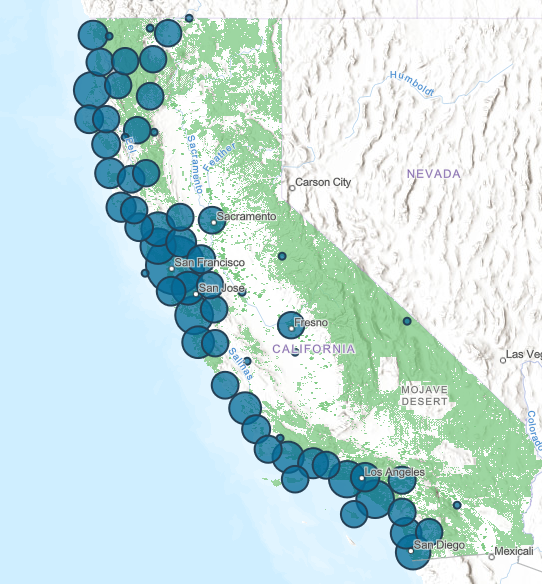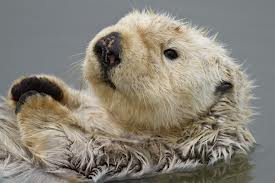Central Coast
The California’s Central Coast is a unique area that offers all the best that the California Coast has to offer. From the redwood forests of the Santa Cruz Mountains to the rugged drama of the Big Sur coast, the wineries and ranch lands of San Luis Obispo and Santa Barbara’s sandy beaches, the beauty of the Central Coast is unsurpassed in the State. The Coastal Conservancy works with local, state, and federal partners to protect and enhance the region’s wildlife and habitats, recreational opportunities, farms and ranches, and waterfront economies. Our goal is to ensure that the natural and scenic resources found so abundantly in the Central Coast persist for the enjoyment of many generations to come.
Central Coast Project Priorities
- Complete the Coastal Trail and Improve Access to the Coast — Beautiful, pristine beaches are found along the entire stretch, many of them backed by rugged coastal mountains. Demand for access continues to grow as the population grows and the region attracts more visitors. Development of the Coastal Trail and improved access to beaches and other protected lands is an important goal in the Central Coast region. There is an ongoing need to link existing trails and to open expand access opportunities, as well as to construct restrooms and other facilities. The Coastal Trail and regional trails that link communities to the coast benefit the region both by providing options for non-motorized transportation, while also expanding recreation opportunities and strengthening the tourist economy.
- Protect Working Landscapes — Throughout much of the Central Coast, agriculture is a predominant land use as evidenced by the high productive fruit and vegetable farms of San Mateo, Santa Cruz and Monterey Counties, as well as the expansive ranch lands of San Luis Obispo and Santa Barbara Counties. Agricultural lands, and in particular range lands, provide additional benefits such as groundwater recharge, wildlife linkages, flood water retention, open space and scenic views. Through its agricultural preservation program, the Conservancy works to protect working lands through acquisition of conservation easements, assistance implementing enhanced management practices, and other measures.
- Protect, Restore and Enhance Fish and Wildlife Habitat — The Central Coast supports a broad range of habitat types from wetlands, to coastal chaparral and grasslands to redwood forests. The region is a biological transition zone from southern to northern California and supports great biological diversity, including many threatened and endangered species. As elsewhere in the coast, central coast streams, wetlands, and other habitats are threatened with various types of development, as well as degraded conditions resulting from past destructive land uses and flood management actions. The Conservancy works to protect and restore these sensitive resources, adopting a holistic perspective that considers the needs of both natural and human communities.
- Increase Climate Resiliency — With sea level rise, increased storm intensity, and other impacts of climate change, coastal habitats will experience significant stress and change in the coming years. Through its Climate Ready Program, the Coastal Conservancy is working throughout the Central Coast to help local communities prepare for these changes and to increase the resiliency of the coastal ecosystems.
- Support Restoration of Waterfronts — Waterfronts in communities throughout the Central Coast offer support local economies through commercial fishing, recreational boating and fishing, tourism, marine science facilities, and other activities. The Coastal Conservancy works with local communities to revitalize waterfronts and promote economic development through sustainable use of their coastal resources. By caring for their resources, coastal communities can continue to reap the economic benefits for years to come.
Central Coast Projects
Click on the links below to find out more about the Coastal Conservancy’s work.
Central Coast News
- Coastal Conservancy Awards Grants for Climate Resilience, Public Access, and Habitat Restoration6/7/2024 – Yesterday, the Board of the State Coastal Conservancy authorized grants for climate resilience, public coastal access, and habitat restoration along the California coast and San Francisco Bay. The grants awarded were: NORTH COAST A grant of up to $100,000 to the Yurok Tribe to undertake the Prairie Creek at Elk Meadow Cabins Habitat Enhancement […] (Read more on Coastal Conservancy Awards...)
- Press Release: Coastal Conservancy Awards over $40 million for coastal access, restoration, and climate resilienceOakland, CA (4/18/2024) – Today, the Board of the State Coastal Conservancy approved grants totaling over $40 million for coastal access, restoration, and climate resilience. Among the grants awarded today are: A grant of up to $6,000,000 to Humboldt County Resource Conservation District to undertake the North Coast Wildfire Resilience Planning and Implementation Grant Program, which […] (Read more on Press Release: Coastal...)
- Sea Otter Recovery Grants RFP Now Open!The California State Coastal Conservancy announces the availability of grants to public agencies, tribes and nonprofit organizations for projects that facilitate the recovery of the southern sea otter along California’s coasts. The California Sea Otter Fund is one of the state’s tax check-off funds that allows taxpayers to voluntarily contribute to the recovery of California’s […] (Read more on Sea Otter Recovery...)

 Help Save Sea Otters at Tax Time
Help Save Sea Otters at Tax Time


